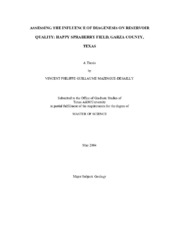| dc.contributor.advisor | Ahr, Wayne M. | |
| dc.creator | Mazingue-Desailly, Vincent Philippe Guillaume | |
| dc.date.accessioned | 2004-09-30T01:40:30Z | |
| dc.date.available | 2004-09-30T01:40:30Z | |
| dc.date.created | 2003-05 | |
| dc.date.issued | 2004-09-30 | |
| dc.identifier.uri | https://hdl.handle.net/1969.1/27 | |
| dc.description.abstract | In the Permian Basin, strata of Leonardian age typically consist of interbedded carbonates and siliciclastics interpreted to be turbidite deposits. Happy Spraberry Field produces from a 100-foot thick carbonate section in the Lower Clear Fork Formation (Lower Leonardian) on the Eastern Shelf of the Midland Basin. Reservoir facies include oolitic- to-skeletal grainstones and packstones, rudstones and in situ Tubiphytes bindstones. Depositional environments vary from open marine reefs to shallow marine oolitic shoal mounds. Best reservoir rocks are found in the oolitic-skeletal packstones. Diagenesis occurred in several phases and includes (1) micritization, (2) stabilization of skeletal fragments, (3) recrystallization of lime mud, (4) intense and selective dissolution, (5) precipitation of four different stages of calcite cement, (6) mechanical compaction, (7) late formation of anhydrite and (8) saddle dolomite and (9) replacement by chalcedony. Oomoldic porosity is the dominant pore type in oolitic grainstones and packstones. Incomplete dissolution of some ooids left ring-shaped structures that indicate ooids were originally bi-mineralic. Bacterial sulfate reduction is suggested by the presence of (1) dissolved anhydrite, (2) saddle dolomite, (3) late-stage coarse-calcite cement and (4) small clusters of pyrite. Diagenetic overprinting on depositional porosity is clearly evident in all reservoir facies and is especially important in the less-cemented parts of the oolitic grainstones where partially-dissolved ooids were subjected to mechanical compaction resulting in "eggshell" remnants. Pore filling by late anhydrite is most extensive in zones where dissolution and compaction were intense. Finally, a porosity-permeability model was constructed to present variations in oolitic packstone- rudstone-bindstone reservoir rocks. The poroperm model could not be applied to oolitic grainstone intervals because no consistent trends in the spatial distribution of porosity and permeability were identified. Routine core analysis did not produce any reliable value of water saturation (Sw). An attempt to take advantage of wireline log data indicates that the saturation exponent (n) may be variable in this reservoir. | en |
| dc.format.extent | 8536835 bytes | en |
| dc.format.extent | 84598 bytes | en |
| dc.format.medium | electronic | en |
| dc.format.mimetype | application/pdf | |
| dc.format.mimetype | text/plain | |
| dc.language.iso | en_US | |
| dc.publisher | Texas A&M University | |
| dc.subject | carbonates | en |
| dc.subject | reservoir quality | en |
| dc.subject | diagenesis | en |
| dc.subject | Happy Spraberry Field | en |
| dc.subject | Leonardian | en |
| dc.subject | bacterial sulfate reduction | en |
| dc.subject | calcite cement | en |
| dc.subject | dissolution | en |
| dc.subject | bi-mineralic ooids | en |
| dc.title | Assessing the influence of diagenesis on reservoir quality: Happy Spraberry Field, Garza County, Texas | en |
| dc.type | Book | en |
| dc.type | Thesis | en |
| thesis.degree.department | Geology and Geophysics | en |
| thesis.degree.discipline | Geology | en |
| thesis.degree.grantor | Texas A&M University | en |
| thesis.degree.name | Master of Science | en |
| thesis.degree.level | Masters | en |
| dc.contributor.committeeMember | Willis, Brian J. | |
| dc.contributor.committeeMember | McVay, Duane A. | |
| dc.type.genre | Electronic Thesis | en |
| dc.type.material | text | en |
| dc.format.digitalOrigin | born digital | en |


